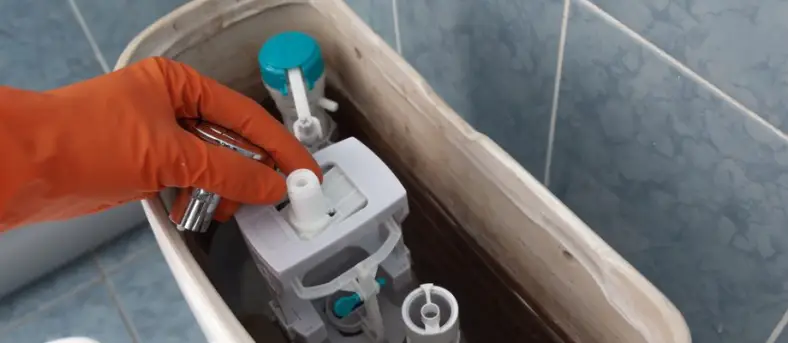Mohave County, Arizona, has a well-known problem: hard water. Harwich Water Department lists Arizona as having some of the hardest groundwater in the U.S. Hard water is not dangerous to humans, but the minerals can wreak havoc on your plumbing.
If you are experiencing calcium buildup or other hard water problems, call Plumbing By Jake at (928) 377-5910 or fill out our online form. We are the local plumbing experts Mohave County residents rely on for hard water treatment.
What Causes Mineral Deposits?
According to McGill University, hard water contains high amounts of dissolved materials, including calcium, chlorides, magnesium salts, and sulfates. As the minerals rush through your pipes, they leave behind residue.
Over time, calcium buildup produces scale. Scale forms white rings on pots, pans, glassware, appliances, and the inside of pipes.
Scale is commonly found in the bathroom. It can cause toilet issues, such as cloudy water and slow-flushing. Calcium buildup creates a white or rust-colored rim around the toilet water line and leaves hard water stains in toilet bowls.
How to Treat Calcium Buildup in Toilet Pipes
Mineral deposits can make your bathroom look dirty and unkempt. The calcium buildup can also stress toilet pipes, increasing your risk of future clogs and leaks. If you spot scale around bathroom fixtures, you need to take action.
Dissolve Visible Scale Buildup
Check the rim feed and jet holes (located where water enters the toilet bowl after flushing). Calcium commonly accumulates in these areas.
If the jet holes are clogged with calcium, water may be restricted from flowing into the bowl. Use a wire coat hanger to poke the jet holes and dissolve any buildup. You can also use a pin, but be sure not to flush it down the toilet.
Scrub Away Scale
Mineral deposits are alkaline. That means acidic liquids, like vinegar and lemon juice, naturally dissolve calcium buildup.
Scoop out excess fluid from the toilet bowl so you can easily reach the calcium deposits. Pour distilled vinegar or lemon juice over the areas. Let the acidic liquids sit in the bowl overnight. The next day, use a stiff-bristled brush to scrub away any remaining deposits.
Eliminate Buildup in Pipes
Scrubbing away visible calcium deposits is simple, but what about the mineral buildup in your toilet pipes? To dissolve mineral deposits in your pipeline, pour one cup of distilled white vinegar into the toilet’s overflow tube (located in the toilet tank).
Let the vinegar sit for at least thirty minutes before flushing. The acid in the vinegar will break down calcium deposits and prevent scale stains from reappearing in your toilet bowl.
Natural Remedies Not Working? Turn to Chemical Solutions
If the calcium buildup is severe, you may need something more substantial than vinegar. Lime Away and CLR are very effective in removing calcium deposits.
Pour a small amount of chemical solution into the toilet’s overflow tank. Let it sit for at least ten minutes before flushing. If the buildup is severe, leave the chemical product to sit in the tank overnight.
When handling chemical scale cleaners, wear rubber gloves and use eye protection. Open a window or turn on your bathroom’s fan. Feel free to call a professional plumber for advice or assistance.
How to Prevent Calcium Buildup
There are two ways to prevent long-term calcium buildup in pipes:
- Perform regular toilet tank cleanings
- Invest in a water softener
As for preventing hard water stains in your toilet bowl, keep up with regular cleanings. Use a safe toilet bowl cleaner and scrub your bowl at least once a week. Pay close attention to the area under the rim, where calcium deposits like to linger.
Deep-Clean Your Toilet Tank Every Six Months
A toilet tank is where calcium, rust, bacteria, mold, and mildew like to hide. Not only do these particles harm pipes, but they also lead to foul odors. Deep-cleaning your tank prevents buildup, reduces potent smells, and increases pipe longevity.
Use White Vinegar to Prevent Buildup
According to This Old House, people should deep-clean their toilet tank twice a year. The process doesn’t require fancy chemical solutions- distilled white vinegar will do the trick. Remove the tank cover and pour in white vinegar until it is one inch below the top rim.
Let the vinegar sit for twelve hours, giving it time to dissolve any lingering mineral deposits. Flush three to five times. Turn off the water valve (usually located at the bottom of the toilet) and flush to drain the tank.
Grab a cleaning brush and scrub the tank’s interior. Use a sponge to wipe any rust from metal parts. Turn the water back on, flush the toilet to refill the tank and bowl, and replace the tank cover. Set a reminder to clean your pipes again in six months.
Install a Water Softener
If hard water buildup is a significant concern, then invest in a softening system
These mechanisms target the source of your plumbing problems by treating hard water before it enters toilet pipes. The equipment prevents calcium from infiltrating your plumbing system and damaging pipes.
In addition to preventing scale buildup, a softener will significantly reduce soap scum residue and staining while increasing the lifespan of household appliances.
How Do Softener Systems Work?
Softeners use ion exchange to treat hard water.
Tiny resin beads inside the softener carry a negative charge, attracting positively charged minerals like calcium and magnesium. The beads pull minerals from the water as they pass through the softener tank.
A small amount of added salt recharges the beads, allowing them to begin the process all over again.
Need Help Removing Calcium Buildup from Your Pipes? Call Plumbing By Jake
The qualified technicians at Plumbing By Jake know how to treat calcium buildup in toilet pipes. If your pipelines need professional assistance, we are the team you can trust. Call us at (928) 377-5910 or complete our online contact form now.

